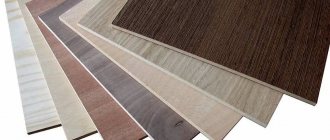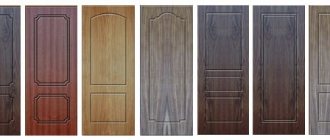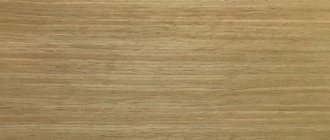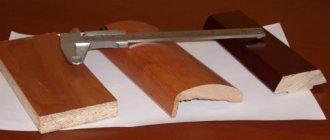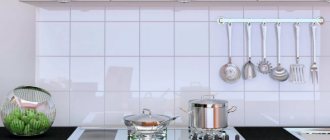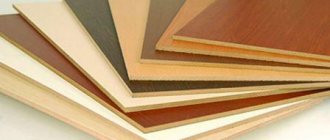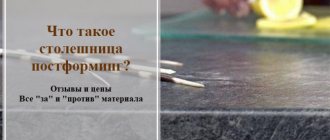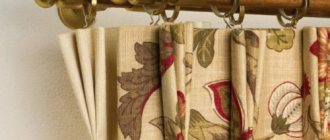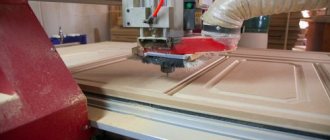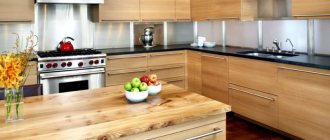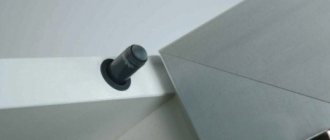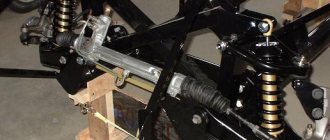MDF is a type of wood board that is a significant competitor to chipboard and laminated chipboard. The abbreviation MDF (Medium Density Fiberboard) translates as “medium density fiberboard.” This material is produced cut into slabs of various thicknesses and sizes.
The wood is pre-dried and crushed. Its particles are fastened together to form slabs of a certain thickness. It is made by pressing under enormous pressure and additional heating at high temperatures. Lignin or paraffin is used as a fastening component. Both of these substances are of natural origin.
MDF first appeared in the USA in 1966. It was here that its production on an industrial scale began. Unlike chipboard, no harmful resins that are hazardous to health are used in the production of MDF, which makes this material relatively environmentally friendly. Furniture made from MDF is suitable for children's institutions. The article talks in detail about the material and its areas of application, adds a couple of useful videos on the topic, and also offers the reader interesting material for downloading.
What is MDF.
Technical characteristics of MDF
Values of physical and mechanical parameters of MDF boards
| Options | Unit | Requirements TU 5536-003-50113531-2005 | Research according to standards | ||||
| Thickness | mm | >6 <9,0 | >9,0 <12,0 | >12,0 <19,0 | >19,0 <30,0 | >30,0 <45,00 | |
| Density | kg/m3 | For boards of brands: MDF -720÷980; HDF -840÷980; LDF -600÷800 | GOST 10634 | ||||
| Bending strength, not less | MPa | 23 | 22 | 20 | 18 | 17 | GOST 10635 |
| Tensile strength perpendicular to the plane, not less | MPa | 0,65 | 0,60 | 0,55 | 0,55 | 0,50 | GOST 10636 |
| Swelling in 24 hours (for MDF, HDF boards), no more | % | 17 | 15 | 12 | 10 | 8 | GOST 10634 |
| Swelling in 24 hours (for LDF boards), no more | % | 30 | 20 | 20 | 17 | 17 | GOST 10634 |
| Modulus of elasticity at static bending, not less | MPa | For board grades: MDF – 1700; HDF – 2300; LDF – 1700 | GOST 10635 | ||||
| Specific resistance to tearing of the outer layer, not less | MPa | For board grades: MDF – 0.8; HDF – 0.9; LDF – 0.6 | GOST 23234 | ||||
| Formaldehyde content | mg/100 g.s.m. | ≤8 | GOST 27678 | ||||
| Content of mineral impurities | % | ≤0,2 | Method of burning and wiping - infusion of a slab sample in hydrochloric acid | ||||
| Humidity | % | from 3 to 10 | GOST 10634 | ||||
| Maximum thickness deviations | mm | ±0,3 | GOST 27680 | ||||
| Maximum deviations of length and width | % | ±5 | GOST 27680 | ||||
| Deviation from right angle | Mmm | ≤2 | GOST 27680 | ||||
| Edge straightness deviation | Mmm | ≤2 | GOST 27680 | ||||
How MDF came to be
The birthplace of MDF is the USA. It was this country that invented and began producing wood panels back in 1966. In the production of MDF, wood fibers are dried, bonded and formed into a board, which is treated with high pressure and high temperature. No harmful resins or phenol are used in the production of MDF. MDF appeared in Russia only in 1997.
In 2022, the production volume of MDF and HDF boards amounted to about 2 million m3. If we take the general dynamics of wood-based panel production in Russia, we can see that since 2011 the market in this area has been continuously growing. In Russia there are 14 enterprises producing MDF boards, but only 13 are operating. The size range of produced boards is divided as follows: thin 3-4 mm, medium thickness 6-28 mm, and massive boards 30-40 mm.
The slabs are produced both untreated and coated. The production of fire-resistant and moisture-resistant boards is being mastered, but most of these boards are exported. The development of the Russian market for MDF boards is a look at the European market; what is popular in Europe comes to the Russian market in 2-3 years and lingers for a long period of time.
Interesting read: why bakelite plywood is so durable.
The consumption of slabs in European production is growing, and the demand for other materials is gradually decreasing. It should be understood that only with large production volumes and affordable prices for MDF boards will the furniture industry gain freedom of choice, and in the future, perhaps, will gradually reorient itself from chipboard to MDF.
MDF panel boards.
Differences in installation method
The laying method is selected depending on the form of release of the material - in the form of sheets, tiles, lining. Wall covering is usually done from the floor to the middle of the vertical surface, less often the entire wall is decorated; decorating the ceilings is more labor-intensive. The thickest panels are used as flooring – at least 20 mm. thick.
A wide range of models will allow you to find the right option depending on your preferences, purpose and budget.
Advice: when decorating the interior with small details, making patterns from MDF, you purchase 10-20% more material.
Sheets
Sheet products are often used to highlight individual zones. They do not have grooves - the joints are formed with decorative seams, elements made of MDF, natural wood, and veneer. Due to their large sizes, the parts are expensive, but have the most uniform texture. Such elements are usually mounted on a sheathing; they can only be properly glued onto a perfectly flat wall.
To decorate a room, it is important that the walls complement the interior.
Advice. To make it more decorative, along the floor and ceiling, skirting boards or cornices are nailed or glued to match the sheet, or contrasting, but combined with other elements of the decor.
Tile
The tiled option is small rectangular, square, triangular parts that allow you to create geometric patterns. Such panels are distinguished by a wide variety of colors and an abundance of texture solutions. When laying on the lathing, the jumpers of the latter are made at a distance that ensures strong fastening of each part.
For modern trends, you can choose more daring solutions.
Lining
It looks like long, relatively narrow panels. The parts are connected by fixing the first element to the wall - a tenon is first cut off from it for better adhesion to the surface. The next part is inserted with a tenon into the groove of the previous one, then all the rest. Laying is done directly on the wall or on a pre-created frame; you can alternate narrow parts by color, creating a “zebra” or smooth gradient changes from dark to light. The panels are arranged horizontally (then laid from bottom to top), vertically, diagonally, and also in a herringbone pattern.
Wood veneer or film coating will perfectly complement a classic interior.
Tip: diagonal laying when decorating the floor allows you to slightly expand the room visually, especially if the material chosen is light and glossy.
Properties and main advantages of MDF boards
MDF board has unique properties, thanks to which this material is significantly superior to fiberboard and chipboard, as its closest competitors. According to its characteristics, MDF board is close to natural wood and belongs to natural materials. The main properties that distinguish MDF from other materials include:
- Strength. Ensured through the use of synthetic resins in the production, as well as due to the dense structure of the fibers obtained during the pressing process using a natural binder - lingin. The density of the finished slab is in the range of 600 – 980 kg/m3. Thanks to this, MDF has the ability to firmly hold fastening materials and fittings. The homogeneous and dense texture eliminates such phenomena as cracking, rotting, and drying out, which are characteristic of natural wood.
- Moisture resistance. The material is resistant to warping and swelling in conditions of high humidity or when exposed to steam. Direct exposure of MDF to water during the day causes the board to swell by 8...30%, depending on its grade and type.
- Heat resistance. As a natural material, MDF is resistant to direct sunlight and temperature changes and does not change its properties under their influence.
- Insulation properties. The material absorbs sounds well and has excellent thermal insulation properties.
- Environmental and hygienic safety. MDF boards belong to class E1 in terms of free formaldehyde emissions (up to 8 mg) and do not contain harmful resins and phenol. According to hygienic parameters, the material is resistant to fungus and other biological factors.
- High quality. The quality of MDF is determined by the homogeneity of the material and the degree of processing of its front surface. This property allows the use of MDF boards in areas where the quality of the final product is a priority.
- Manufacturability. The quality and homogeneous composition of the MDF board allows it to be processed with almost any tool (mills, saws, drills, abrasives). The material is resistant to chipping during processing and does not crumble. Finished products can be glued well with any wood adhesives, painted and varnished.
What are MDF panels made of?
The material contains wood waste, crushed to dust, compressed and mixed with lignin. Such sheets, in their characteristics, practically do not differ from natural wood; they are more environmentally friendly than chipboard and wood-fiber lumber, since the composition does not contain phenol or other toxic components that can gradually be released into the environment. The MDF surface is covered with melamine film with a wood or other pattern, decorated with natural veneer or painted - industrially or manually.
They perform a protective function and also improve sound insulation.
MDF coating
MDF facades are very popular among furniture manufacturers and buyers. In the manufacture of furniture facades, MDF is used as a base, and the attractive appearance and performance properties depend on the MDF coating. Today, the greatest demand is for PVC-coated MDF, acrylic-coated MDF, enamel-coated MDF, and plastic-coated MDF boards.
Material on topic: All about moisture-resistant plywood.
Coating MDF with PVC film
The furniture facade is laminated with PVC film of the selected color. The advantage of MDF with PVC coating is its affordable price. The film can be of completely different colors, resemble the structure of wood, have a smooth glossy surface, or a matte finish. MDF facades coated with PVC film are popular in both classic and modern interiors. The film is not afraid of cleaning agents and mechanical stress. The only drawback is that with prolonged exposure to high temperatures, this MDF coating may peel off. Despite this, furniture made from MDF with PVC coating can delight its customers for many years.
Covering MDF with PVC film.
MDF enamel coating
Coating MDF facades with enamel is in deserved demand. After all, such a coating offers a wide range of colors not only in monochromatic glossy shades, but also in pearlescent colors, with a chameleon effect or the now popular “ombre”. For this coating, the MDF board is coated with several layers of enamel, then sanded and varnished. This surface does not fade in the sun and is not afraid of high temperatures, water or water. However, it should be borne in mind that this MDF coating has special care requirements - the enamel cannot be cleaned with abrasive agents.
MDF enamel coating.
MDF plastic coating
MDF facades coated with plastic are gaining more and more popularity among our customers. This type of coating combines the properties of film and enamel, and is much cheaper than acrylic and enamel coating. Plastic-coated MDF is resistant to high temperatures and humidity, and retains its original color for many years, even if exposed to sunlight. MDF plastic coating allows you to decorate furniture not only in solid colors, but also in wood, stone and other textures.
MDF plastic coating.
Acrylic MDF coating
MDF facades with acrylic coating are also quite in demand nowadays. Acrylic is environmentally friendly and therefore safe for humans. The acrylic coating of MDF gives a uniform, rich color that is resistant to all kinds of influences and is not afraid of sunlight, temperature changes and high humidity.
Acrylic MDF coating.
MDF wood veneer covering
There are also MDF facades coated with veneer. The MDF board is glued with a thin sheet of wood and therefore such furniture is practically indistinguishable from products made from real solid wood. MDF with this coating is safe, affordable and easy to clean.
MDF covered with wood veneer.
MDF countertop and apron for the kitchen: whether to buy or not
MDF boards are widely popular for kitchen furnishings. Its technical characteristics significantly exceed any other materials in this group, and therefore allow it to come into contact with water almost without fear. Among the most common options are kitchen countertops made of MDF, as well as kitchen aprons.
It is also worth buying an apron for the kitchen from MDF because the variety of design solutions is not inferior to any other material, but the degree of environmental friendliness and resistance to various external factors is pleasantly pleasing. There are a wide variety of color options, including those that imitate surfaces, for example, MDF panels with a stone look.
Finishing kitchen walls and splashback using MDF
In addition, if you buy an MDF profile for framed facades, you can decorate the furniture as you wish. An MDF profile for framed facades is inexpensive, but the possibilities it opens up are extremely great.
Types of MDF
MDF boards are selected depending on the tasks.
- MDF boards with a smooth surface on both sides are used in a wide range of applications as a building material. They can be easily processed, painted, veneered, plastered, or puttyed.
- Laminated MDF. The plate is covered with a thin polymer film on one or both sides. As a result, high-quality protection from mechanical stress, moisture and other negative factors is achieved. Film of various colors can be used.
- Moisture-resistant MDF panels. To create the panels, only high-quality wood is used, which is pressed under prolonged exposure to high temperature. Moisture-resistant MFD wall panels can be used for decorative finishing of bathrooms, balconies and loggias.
It’s worth finding out: what thermowood is.
MDF sanded
Sanded MDF is a board without a decorative coating. It is absolutely smooth, even, and has no internal or external defects. It is mainly purchased by furniture makers who need further processing and decoration.
Question to the expert
What are the most popular sizes and thickness of MDF?
Sanded MDF is produced in several thicknesses: from 3 to 40 mm and, depending on the manufacturer, it can have several sizes: 2440*1830, 2800*2070, 2750*1830, 2620*2070 and others.
MDF is painted and milled (for the production of relief facades). For these purposes, only first-grade MDF is purchased, otherwise any coating on a slab of the worst grade will lie unevenly, with flaws, forming a generally uneven surface.
MDF polished.
Wall panels are usually made from thin MDF boards and are used as the basis for laminated parquet. The use of MDF boards is very common in the production of doors, railings, platbands, staircases, commercial equipment, advertising signs and various exhibition structures.
In addition, MDF board is used as an additional material: for leveling walls, as a substrate for other floor coverings, for invisible parts in furniture production, and partitions. For these purposes, second-grade MDF is suitable, which does not require a perfectly flat surface of the board and the price per MDF sheet will be much cheaper.
MDF painted
This is grade 1 sanded MDF, painted in various decors at the production stage. It is usually used in the production of facades for cabinet furniture. Due to the use of paint, MDF becomes more resistant to high temperatures, moisture, and exposure to the sun.
MDF painted.
MDF veneered
It consists of polished MDF boards of the 1st grade, decorated with veneer - a natural material made from wood. Veneer is a very thin layer of wood glued onto an MDF board, and then covered with a special furniture varnish in several layers. Veneered MDF is a board that can replace products made from natural wood both in terms of its technological, consumer and aesthetic indicators, and in terms of pricing policy in relation to natural wood. These types of boards are also used in the production of furniture and interior decoration. Products made from veneered MDF are very similar to products made from natural wood; they have the same properties, and in addition, many others that products made from natural wood do not have.
Typically, an MDF board is covered with veneer, the thickness of which is 0.6 mm. When talking about the actual thickness of veneered MDF, we mean the thickness of the veneer and the board itself. There are more than 20 colors of veneered MDF: beech, cherry, oak, wenge, etc. The range of board thicknesses ranges from thin - 4 mm to thick - 39 mm. Depending on the quality of the veneer, there is a standard designation for veneered MDF, where A, B, D indicate the sides of the board:
- A/A – high-grade veneer is used, two sides are veneered,
- A/B – high grade veneer is used on one side, lower grade veneer is used on the other side of the board,
- A/G – on side A, high-grade veneer is used, and on the other side, cardboard or stretching made from veneer of any wood species is applied.
MDF veneered.
MDF laminated
This is grade 1 sanded MDF, made from wood fibers, which is covered with film under high pressure. Thanks to the high technology of the production process, today MDF boards have achieved low emission of formaldehyde E1, which meets the international standard. Laminated MDF is more durable, and a huge number of different colors and surface textures satisfy the tastes of a huge number of consumers and make the board a popular material in furniture production.
Single-sided and double-sided laminated white MDF is especially popular. It usually comes in thicknesses of 16mm and 19mm. Single-sided laminated MDF is produced with only one side coated and double-sided, where two sides of the board are laminated. Laminated MDF can be plain (white, gray, etc.), as well as imitating wood (beech, alder, cherry and other species, including expensive ones).
Laminated MDF is a durable material that has sufficient durability due to the laminated surface. In addition, it is quite durable in everyday life, is resistant to various chemicals, and is easy to care for and process. It is also devoid of such disadvantages of natural wood as cracking, warping, its physical and mechanical properties are several times superior to wood, and its cost is almost several times cheaper. All this allows the use of laminated MDF for interior decoration and the production of furniture facades.
MDF laminated.
How to attach MDF panels to the wall and ceiling with your own hands
Even if you have not worked with such material before, it is quite possible to figure out on your own how to attach MDF panels to a wall or ceiling. And first of all, you need to prepare tools and materials. This list includes a simple pencil, a corner for marking right angles, a construction level, a hacksaw, a hammer drill, a screwdriver or hammer, dowels and screws.
The work begins with cleaning the surface on which the fastening will be made. It must be thoroughly cleaned of dust and dirt. In addition, it is necessary to conduct a thorough inspection for the presence of fungi and mold.
If you need to make a ceiling from MDF panels with your own hands, then you will need both guide profiles and hangers, plus wooden blocks that will act as transverse parts of the frame. If we are talking about attaching MDF panels to the wall, then simple wooden blocks or a special plastic sheathing will be enough.
Helpful advice! To make the fastening process easier, it is recommended to use clamps. This will allow you to fix parts of the covering on the sheathing and, in general, will make the task much easier.
Do-it-yourself installation of MDF wall panels on lathing
The most important thing is to make the correct markings for the sheathing, which in the future will allow you to accurately secure all the elements. How to do this correctly can be seen in the photo of ceilings made of MDF panels. At this stage, it is important to take into account that the distance between the fixed panels and the real ceiling should be sufficient to accommodate lamps, as well as other communications.
Installation of MDF wall panels also begins with marking the place where the first lathing strip will be attached (vertical or horizontal does not matter). Maintaining the required distance, all sheathing elements are attached, and after that the installation of MDF wall panels begins. They are fixed quite simply using clamps or self-tapping screws.
Helpful advice! High-quality and certified products can be found on the official Soyuz website. MDF wall panels made from them are highly valued due to their compliance with all requirements and standards.
This is not to say that installing MDF panels on a wall with your own hands is a difficult process. Rather, it is monotonous and requires high accuracy of calculations and constant attention.
Related article:
Thickness and dimensions of plywood sheets: prices, varieties and applications
Plywood: production features, main types of this material, advantages and disadvantages. Review of the building materials market.
Solid or MDF – which is better?
To figure out what is better than MDF or solid wood, you need to look at each of these materials from the outside and draw the appropriate conclusions. First, let's evaluate all the advantages and disadvantages. The main feature of MDF board is its homogeneous composition. Thanks to it, manufacturers can create various products of any shape with proper processing of the material. It is considered the most diverse material used for facades. Many people choose MDF to furnish their kitchens, but what is the reason for this?
What is solid wood?
Let's take a closer look at the advantages:
- similarity to natural materials;
- safety and environmental friendliness. MDF products do not emit toxic substances and fumes harmful to humans;
- has impressive advantages and external data at a low price. Many consumers are limited by a certain budget and cannot afford expensive furniture, and MDF in this case is the best option.
- quite long service life. OVER a long period of use, the material does not undergo any serious changes that would significantly worsen its external condition.
- possibility of fine processing. This fact is useful in the production of modern kitchen models, which is why consumers in most cases choose such furniture for the kitchen.
Solid wood is also popular in furniture production. Of course, this is sometimes a capricious material that requires special care, but this will not overshadow all the advantages and advantages. This is the highest class of quality. But some, due to tenderness, do not want to take such furniture for themselves. All this is due to the fact that, for example, you can’t put a hot mug of tea on oak furniture, and it’s even worse with smokers. Wood absorbs everything you breathe, including smoke. Subsequently, you can see on the surface what is possibly happening inside the smoker.
Solid or MDF.
If you are not a neat person and do not want to take care of your furniture, although any item requires care, then it is better not to look at solid wood furniture. And those who have chosen this excellent option and take care of it from time to time, wipe the surface, treat it with oils, and subsequently enjoy beautiful products that fit perfectly into the interior of the room and give unforgettable emotions to everyone who sees this beauty.
Let us highlight the advantages that allow solid wood furniture to lead over its competitors:
- environmental friendliness. Furniture made from this material is 100% guaranteed not to harm your health, because it is essentially natural wood with a beautiful finish. There are no toxic impurities or other nasty things in it!
- practicality. Although we touched on the topic of constant care, by its nature solid wood, unlike the familiar chipboard and MDF, tolerates moisture much better and is resistant to rotting. And the use of protective coatings and care products will improve the effect several times more. For example, by covering a table with polyurethane varnish, you can even allow yourself to place a hot object on it.
- aesthetics and combination with the interior. When talking about the similarity of MDF to natural wood, we were talking about similarity or imitation, but nothing more. Natural wood has always been the standard of beauty and fits perfectly into a variety of room designs, adding special charm and luxury to it.
- indescribable energy. In addition to the fact that real wood furniture gives coziness and comfort, it also creates an extremely positive atmosphere and fills it with special energy. Every owner of solid wood furniture will confirm this fact and sign every word.
When it comes to purchasing, the question arises: what is better solid wood or MDF for the kitchen. There cannot be a definite answer here, since everyone has their own needs, tastes and preferences. Unusual and interesting options are made from MDF, which most people like better than from solid wood. The choice should be made taking into account the many facts that we described above, and you also need to approach the issue taking into account your financial situation. MDF is a great alternative to real wood, but investing in real wood furniture is not just a practical and eco-friendly choice for people who appreciate nature's graceful simplicity. It is also an investment in the health and harmony of your family.
Types of MDF finishing.
Advantages
- The versatility of the material. Due to the structure of the material, it is very popular and widely used in various areas of human life: furniture industry, construction, interior design.
- Practicality. MDF is a fairly hard material and is not subject to minor mechanical damage. In addition, due to their density, the slabs perfectly hold fasteners, which significantly extends the life of furniture, wall or ceiling panels.
- Decorative. A rich variation range of MDF boards allows even the most demanding consumer to choose an option.
- Environmental friendliness. In the manufacture of MDF panels, no synthetic additives are used, which makes it possible to compare the safety of the material with natural wood. The use of natural ingredients makes MDF safe for health. Even over time, the material does not emit toxic compounds.
- Hygiene. Fiberboards are not subject to the natural process of decay, as well as to the influence of other pathogens that destroy the base of the material.
- Moisture resistance. MDF is not exposed to moisture, does not swell or warp.
- Uniformity of the material. MDF boards are made from a homogeneous mass of wood fibers mixed with an adhesive composition, which guarantees the absence of external and internal defects. The slabs are absolutely smooth and even.
- Lifetime. Compared to solid wood furniture, MDF products will last much longer if properly cared for.
- Heat and sound insulation.
MDF panels
MDF (Medium Density Fiberboard) is a popular finishing material, medium-hard chipboard. An analogue of fiberboard, with the only difference that MDF has a higher density (600-1200 kg/m3). Manufactured by hot pressing. The essence of the technology is that lignin fibers present in wood shavings become plastic under the influence of high temperatures and adhere tightly to each other. This ensures the strength of the material. In the production of panels, urea resins modified by melanin are used.
The first MDF panels appeared in 1966 in the USA. In Russia they became known only in 1997. At the moment, China is the leader in sales volume among manufacturers by a large margin.
Installation methods
Mounting options for MDF panels
There are two main ways to install MDF panels:
- Creating a sheathing This is a rather labor-intensive procedure. The frame is constructed from wooden beams or a metal frame. This method is suitable for cases where the base has significant drawbacks. The made frame allows for additional insulation. It is important to consider that wood fiber products are fastened taking into account the correct location of the profile posts.
- Sticker The simplest method, which makes it possible to lay the material very quickly. But it must be taken into account that the surface must be perfectly prepared. The sticker is made using “liquid glue”.
From all of the above, it becomes extremely clear what MDF panels are. This is a truly unique material that allows you to get a stylish and modern interior.
Features of installing MDF-based panels
MDF panels are installed by craftsmen who have experience working with this material or with their own hands. The parts are glued directly to the wall, floor, or a sheathing is pre-created. First you need to stock up on all the necessary tools, compounds, and materials.
MDF must have properties such as low flammability, non-flammability and inability to spread flame.
On the frame
Creating a frame is justified in large rooms with very uneven walls - its structure “eats” up to several tens of centimeters on each side. The sheathing is made of timber and metal profiles. The number of racks resting on the floor and crossbars of the frame depends on the type of wood-fiber material used - panels, sheets, tiles. The distances between the fastening points are no more than 40-50 cm, from the edge of each part - no less than one cm.
The advantage of a wooden frame is ease of installation, environmental friendliness and the use of fewer hardware and connecting parts.
For installation you will need a screwdriver, an electric drill, nails, self-tapping screws, dowels, a hammer, a building level, and perforated corners. With the help of a frame structure, it is easy to hide any communications and wall defects. Particular attention is paid to the space above windows, doors, around pipes and lamps.
Installing a metal frame has its own difficulties - it requires a certain skill and the acquisition of special tools.
Advice: in wet rooms, the frame is treated with protective compounds.
On glue
Gluing of parts is done using “liquid nails”, “Moment” glue, “Titanium”, and other universal compounds. To simplify the work, use a glue gun. If additional sealing is required, polyurethane foam is used. It is advisable to remove excess glue immediately, before it dries.
The frameless method is chosen only when the bases in the room have a perfectly flat surface.
The walls will have to be prepared - remove old coverings (wallpaper, tiles, paint), get rid of mold, cover the surfaces with a primer. Next, the walls are marked, the parts are cut to size with a hacksaw or jigsaw. Adhesive composition. To save money, apply in dots, press tightly, and align the joints. Afterwards, the seams are filled with sealant, decorated with narrow decorative details, and left to dry for 24-36 hours.
Work should begin from the corner of the room, moving towards the window.
Advice: when making “patterns” (laying “herringbone”, “checkerboard”, etc.), first fix large parts, then smaller fragments.
Where is it used?
It is considered the best alternative to many finishing materials, therefore it is widely used in many areas. Its decorative boards are used for the production of furniture, especially the unforgettable facades of cabinets in the kitchen, children's room, hallway and living room. In the automotive industry, they are used to trim parts in car interiors. Construction companies use MDF for repairs and finishing of floors and walls. It is also used for the manufacture of various containers. This material makes excellent doors and door frames, as well as wall partitions. You can find out what MDF plinth is from our article.
MDF is used in the advertising business - exhibition stands are made from it. In electronics, it has found application in the production of speakers and other acoustic systems.
As part of the topic, it is useful to read about what fiberboard is.
MDF is a decorative material that has found application in various industries. It adequately replaces wood and at the same time costs half as much. It is not inferior to it in quality, and in some characteristics it far exceeds the indicators. In order not to get confused in concepts, it is also worth finding out what HDF is and whether it is suitable for your work. It is the best option for those who want to carry out repairs or assemble furniture using high-quality materials, without prohibitive costs.
Useful tips for caring for MDF
Elements laid or installed in accordance with all the rules require minimal maintenance. The most important thing is to protect them from direct contact with water. Once every few weeks, as dust accumulates on the surfaces, wipe the MDF with a slightly damp cloth or soft cloth. Even if there is serious contamination, it is unacceptable to use hard brushes or abrasive compounds that can scratch the material. You can use liquid household chemicals in small quantities. If the panels are already old, scratched, worn, but stick firmly to the wall, it is permissible to cover them with wallpaper, colored self-adhesive films or paint them.
What characteristics should you pay attention to when choosing?
To choose the right option for wall decoration, it is worth considering a number of recommendations. Worthy of attention:
- The purpose of the upcoming finishing. If MDF panels are chosen exclusively for decorative finishing, then it is enough to choose products with a thickness of less than 12 mm. This will be enough for a beautiful wall decoration. If it is necessary to increase the heat and sound insulation properties of the base, you should give preference to thicker products;
- Availability of certificates of conformity. These documents confirm the safety of the finished product. MDF boards should not contain toxic resins, formaldehyde and other substances that have a negative impact on human health;
- Product integrity. All elements of the batch must be free from defects and defects. The presence of cracks, irregularities, and other damage is unacceptable.
- Uniformity of the front surface. Low-quality material often has an uneven texture, which becomes clearly visible after installation work is completed;
- Dimensions of MDF panels. When choosing, you should focus on the design project being implemented. All elements must have the same geometric parameters;
- Tensile strength declared by the manufacturer. Its value varies in the range of 17 – 23 MPa. The higher the parameter, the greater the pressure the product can withstand during operation;
- Humidity level varying in the range of 3 – 10%;
- Product density;
- The level of moisture resistance that determines the possible area of use of MDF panels;
- Compound. It is desirable to have fire retardants, which increase the level of fire resistance of the product.
